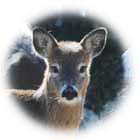
Pellet Group Inventory (P.G.I.)
Issue/Problem Statement
 Knowledge of the size of Nova Scotia's deer herd together with condition, reproduction, age/sex ratios and mortality factors, are used in assessing herd status and recommending hunting regulations. As deer are very difficult to inventory directly, a method of indirectly estimating numbers has been developed which is based on a count of deer pellet piles deposited throughout the winter period.
Knowledge of the size of Nova Scotia's deer herd together with condition, reproduction, age/sex ratios and mortality factors, are used in assessing herd status and recommending hunting regulations. As deer are very difficult to inventory directly, a method of indirectly estimating numbers has been developed which is based on a count of deer pellet piles deposited throughout the winter period.
The number of moose on mainland Nova Scotia are very low and have continued to decline since 1981 when all hunting of moose on the mainland was discontinued. Their low numbers and scattered distribution, as well as infrequent periods of appropriate early winter weather required to do proper aerial surveys, have resulted in an inability to monitor their status. Consequently, a decision was made in year 2000 to transfer staff effort every third year, from the deer P.G.I. program to conducting a moose P.G.I. in areas of mainland Nova Scotia where it is logical to strive to maintain a viable moose population. In the remaining areas of the province, deer P.G.I. counts are maintained to provide some trend information in these years.
Moose P.G.I.s were completed in spring 2000 and 2003, with the intent of repeating the same sample plots in 2006, 2009,etc., for the purpose of monitoring trend in abundance and distribution. This program is not intended to be used for estimating density or numbers of moose but only to gain some insight into overall abundance (ie increasing, stable, decreasing).
Objective
To estimate the size of Nova Scotia's over-wintering deer herd in two of three years and to monitor relative abundance and distribution of moose on mainland Nova Scotia in every 3rd year.
Methods
In spring, after the snow melts and prior to green-up, NR&R staff throughout the province survey some 460 (2 m wide, 1 km long) randomly selected transects. The number of deer/moose pellet piles observed are recorded. These numbers are used to calculate deer density and ultimately estimate herd size. Every third year a number of these "deer" transects on mainland Nova Scotia, are dropped and replaced with "moose" transects. These moose transects have been located within areas known to be inhabited by at least some number of moose. All remaining "deer" transects continue to be completed in these years. Both deer and moose pellet piles are counted on all lines.
Partners
Regional Services Staff
Project Dates and Duration
Depending on snow melt and green-up, field work completed within April and May, annually.
Progress to Date
In Spring, 1999, overwinter herd size estimate was 71,085. This represents an increase of 6% as compared to Spring, 1998(67,069), and a 66% increase over Spring 1995.
In Spring of 1986 herd size was estimated at an all time high of 119,224. The 1986 herd size is felt to have exceeded range capacity. Currently, herd size objective is 80,000 deer provincially, as estimated by the P.G.I. survey.
Results of the Pellet Group Inventory (PGI) indicate Nova Scotia's deer density peaked in 1986 at a provincial average of 2.74 deer/km². Overwintering deer density estimates were lower each year thereafter until the spring of 1995 when the average density of deer in the province had dropped to just below one deer per square kilometre.
The 1996 PGI results indicated a slight increase in provincial deer density and herd size continued to grow annually through the spring of 1999. However, the overwintering deer density estimate between 1999 and 2000 dropped by 11% and has continued to decline every year since. The spring 2003 overwintering deer density estimate is 0.93 deer/km².
Deer densities experienced in the mid 1980's are believed to have exceeded the biological carrying capacity for deer in Nova Scotia. The current overwintering deer density objective, as estimated by the PGI, is 1.80 deer/km2, or roughly 80,000 deer province wide."
| White-Tailed Deer Densities and Corresponding Population Estimates Calculated From the Pellet Group Inventory, 1983 - 2003 |
||
| Year |
Average
Density |
Population |
|
|
1.84 | 82682 |
| 1984 | 1.96 | 86355 |
| 1985 | 2.43 | 107857 |
| 1986 | 2.74 | 124150 |
| 1987 | 2.49 | 112324 |
| 1988 | 2.00 | 91197 |
| 1989 | 1.76 | 78327 |
| 1990 | 1.70 | 75732 |
| 1991 | 1.26 | 55608 |
| 1992 | 1.28 | 57054 |
| 1993 | 1.16 | 53082 |
| 1994 | 1.00 | 45056 |
| 1995 | 0.94 | 42764 |
| 1996 | 1.02 | 46705 |
| 1997 | 1.29 | 58334 |
| 1998 | 1.49 | 67069 |
| 1999 | 1.71 | 71085 |
| 2000 | 1.52 | 68592 |
| 2001 | 1.21 | 56646 |
| 2002 | 1.15 | 51391 |
| 2003 | 0.93 | 43279 |
Reporting
Internal and available to public upon request.
Management Recommendations
- Complete the full Deer P.G.I. program survey 2 of 3 years on schedule 2001, 2002, ---, 2004, 2005, ---, 2007, etc.
- In areas of mainland Nova Scotia where it is feasible and logical to maintain a viable population of moose, transfer same effort to completion of designated moose transects, every third year. (i.e. years 2000,2003,2006, etc.) During years of emphasis on moose, complete remaining original (since 1983) deer transects to maintain trend information and the ability to detect major deer population changes, should that occur.
Final Report: Annual - June
Completion Date: Ongoing annually